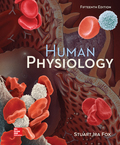
EBK HUMAN PHYSIOLOGY
15th Edition
ISBN: 8220106796238
Author: Fox
Publisher: YUZU
expand_more
expand_more
format_list_bulleted
Question
Chapter 6, Problem 16RA
Summary Introduction
To explain:
The conditions required to produce osmosis.
Introduction:
Osmosis is the spontaneous movement of solvent molecules. It occurs through a selectively permeable membrane. It is the movement of solvent molecules into a region of high solute concentration. It tends to equalize solute concentration.
Expert Solution & Answer
Want to see the full answer?
Check out a sample textbook solution
Students have asked these similar questions
What is the structure and function of Eukaryotic cells, including their organelles? How are Eukaryotic cells different than Prokaryotic cells, in terms of evolution which form of the cell might have came first? How do Eukaryotic cells become malignant (cancerous)?
What are the roles of DNA and proteins inside of the cell? What are the building blocks or molecular components of the DNA and proteins? How are proteins produced within the cell? What connection is there between DNA, proteins, and the cell cycle? What is the relationship between DNA, proteins, and Cancer?
Why cells go through various types of cell division and how eukaryotic cells control cell growth through the cell cycle control system?
Chapter 6 Solutions
EBK HUMAN PHYSIOLOGY
Ch. 6 - Describe the distribution of fluid in the body.Ch. 6 - Describe the composition of the extracellular...Ch. 6 - List the subcategories of passive transport and...Ch. 6 - Explain what is meant by simple diffusion and list...Ch. 6 - Prob. 4CPCh. 6 - Prob. 5CPCh. 6 - Explain how the body detects changes in the...Ch. 6 - Prob. 7aCPCh. 6 - Prob. 7bCPCh. 6 - Prob. 7cCP
Ch. 6 - Prob. 8CPCh. 6 - Prob. 9aCPCh. 6 - Prob. 9bCPCh. 6 - Explain the relationship of the resting membrane...Ch. 6 - Prob. 10bCPCh. 6 - Prob. 11CPCh. 6 - Prob. 12CPCh. 6 - The movement of water across a plasma membrane...Ch. 6 - Which of these statements about the facilitated...Ch. 6 - Prob. 3RACh. 6 - Prob. 4RACh. 6 - Blood plasma has an osmolality of about 300 mOsm....Ch. 6 - Prob. 6RACh. 6 - The most important diffusible ion in the...Ch. 6 - Prob. 8RACh. 6 - Prob. 9RACh. 6 - Prob. 10RACh. 6 - Prob. 11RACh. 6 - Prob. 12RACh. 6 - Prob. 13RACh. 6 - Prob. 14RACh. 6 - Which of the following questions regarding second...Ch. 6 - Prob. 16RACh. 6 - Prob. 17RACh. 6 - Compare the resting membrane potential of a neuron...Ch. 6 - Prob. 19RACh. 6 - Prob. 20RACh. 6 - Prob. 21RACh. 6 - Prob. 22RACh. 6 - Using the principles of osmosis, explain why...Ch. 6 - Prob. 24RACh. 6 - Prob. 25RACh. 6 - Prob. 26RACh. 6 - Prob. 27RACh. 6 - Prob. 28RACh. 6 - Prob. 29RACh. 6 - Prob. 30RACh. 6 - Using only the information in this chapter,...Ch. 6 - Prob. 32RACh. 6 - Prob. 33RACh. 6 - Suppose a semipermeable membrane separates two...Ch. 6 - Prob. 35RACh. 6 - Prob. 36RACh. 6 - Use the Nernst equation and the ion concentration...
Knowledge Booster
Learn more about
Need a deep-dive on the concept behind this application? Look no further. Learn more about this topic, biology and related others by exploring similar questions and additional content below.Similar questions
- In one paragraph show how atoms and they're structure are related to the structure of dna and proteins. Talk about what atoms are. what they're made of, why chemical bonding is important to DNA?arrow_forwardWhat are the structure and properties of atoms and chemical bonds (especially how they relate to DNA and proteins).arrow_forwardThe Sentinel Cell: Nature’s Answer to Cancer?arrow_forward
- Molecular Biology Question You are working to characterize a novel protein in mice. Analysis shows that high levels of the primary transcript that codes for this protein are found in tissue from the brain, muscle, liver, and pancreas. However, an antibody that recognizes the C-terminal portion of the protein indicates that the protein is present in brain, muscle, and liver, but not in the pancreas. What is the most likely explanation for this result?arrow_forwardMolecular Biology Explain/discuss how “slow stop” and “quick/fast stop” mutants wereused to identify different protein involved in DNA replication in E. coli.arrow_forwardMolecular Biology Question A gene that codes for a protein was removed from a eukaryotic cell and inserted into a prokaryotic cell. Although the gene was successfully transcribed and translated, it produced a different protein than it produced in the eukaryotic cell. What is the most likely explanation?arrow_forward
- Molecular Biology LIST three characteristics of origins of replicationarrow_forwardMolecular Biology Question Please help. Thank you For E coli DNA polymerase III, give the structure and function of the b-clamp sub-complex. Describe how the structure of this sub-complex is important for it’s function.arrow_forwardMolecular Biology LIST three characteristics of DNA Polymerasesarrow_forward
arrow_back_ios
SEE MORE QUESTIONS
arrow_forward_ios
Recommended textbooks for you
 Concepts of BiologyBiologyISBN:9781938168116Author:Samantha Fowler, Rebecca Roush, James WisePublisher:OpenStax College
Concepts of BiologyBiologyISBN:9781938168116Author:Samantha Fowler, Rebecca Roush, James WisePublisher:OpenStax College Human Physiology: From Cells to Systems (MindTap ...BiologyISBN:9781285866932Author:Lauralee SherwoodPublisher:Cengage Learning
Human Physiology: From Cells to Systems (MindTap ...BiologyISBN:9781285866932Author:Lauralee SherwoodPublisher:Cengage Learning Human Biology (MindTap Course List)BiologyISBN:9781305112100Author:Cecie Starr, Beverly McMillanPublisher:Cengage Learning
Human Biology (MindTap Course List)BiologyISBN:9781305112100Author:Cecie Starr, Beverly McMillanPublisher:Cengage Learning Biology Today and Tomorrow without Physiology (Mi...BiologyISBN:9781305117396Author:Cecie Starr, Christine Evers, Lisa StarrPublisher:Cengage Learning
Biology Today and Tomorrow without Physiology (Mi...BiologyISBN:9781305117396Author:Cecie Starr, Christine Evers, Lisa StarrPublisher:Cengage Learning Biology 2eBiologyISBN:9781947172517Author:Matthew Douglas, Jung Choi, Mary Ann ClarkPublisher:OpenStax
Biology 2eBiologyISBN:9781947172517Author:Matthew Douglas, Jung Choi, Mary Ann ClarkPublisher:OpenStax

Concepts of Biology
Biology
ISBN:9781938168116
Author:Samantha Fowler, Rebecca Roush, James Wise
Publisher:OpenStax College

Human Physiology: From Cells to Systems (MindTap ...
Biology
ISBN:9781285866932
Author:Lauralee Sherwood
Publisher:Cengage Learning

Human Biology (MindTap Course List)
Biology
ISBN:9781305112100
Author:Cecie Starr, Beverly McMillan
Publisher:Cengage Learning

Biology Today and Tomorrow without Physiology (Mi...
Biology
ISBN:9781305117396
Author:Cecie Starr, Christine Evers, Lisa Starr
Publisher:Cengage Learning


Biology 2e
Biology
ISBN:9781947172517
Author:Matthew Douglas, Jung Choi, Mary Ann Clark
Publisher:OpenStax
Cell Differentiation | Genetics | Biology | FuseSchool; Author: FuseSchool - Global Education;https://www.youtube.com/watch?v=gwAz_BtVuLA;License: Standard YouTube License, CC-BY